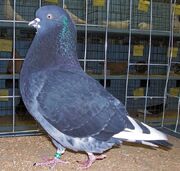
The Birmingham Roller is a breed of domesticated pigeon that originated in England, where they were developed via selective breeding, for their ability to do rapid backward somersaults while flying.[1] As the name suggests and as also mentioned by Wendell Levi in his book The Pigeon, this breed was developed in and around the City of Birmingham in England. The Birmingham Roller has a flying type and a show type. Show Rollers are larger than the flying variety, and are bred just for show. A similar breed called a Parlor Roller look much like Birmingham Rollers, but can't fly...they spin back somersaults on the ground for many yards. Oriental Rollers are another aerial performer and come in many color varieties. Some fanciers fly their rollers in competition, both locally and nationally. There is even a World Cup competition that includes several other countries. Kits (group of pigeons) are scored for quality and depth, as well as the number of birds in a turn.
With about 10,000 breeders around the world, Birmingham Rollers are a very popular breed of domesticated, performing pigeon. Fanciers are found from as far as the deserts of Kuwait, to the marshy backwoods of Louisiana. From the concrete jungle of the Bronx to the asphalt, palm-lined streets of Los Angeles, roller fanciers number in the thousands in the United States alone. Breeders come in all ages and backgrounds, from the kid breeding out of a makeshift pen in the backyard, to the organized and elaborate setups of today's well known veteran breeders.
What is a Roller Pigeon?[]
In the words of William H. Pensom, "The Birmingham Roller is noted for its exclusive ability to turn over backwards and rotate with inestimable speed for considerable distances downwards." This 8 ounce feathered friend is genetically programmed to flip backwards, provided adequate training, diet, and exercise. The spinning can appear to be so fast that the bird looks like a ball of feathers falling toward the ground. They recover from the spin and return to their flock, called a “kit” in competition. The pigeon continues to do the same acrobatics with regular frequency, often in unison with other birds in the kit. The frequency, depth, style, tightness of roll, and angle are all determined by careful and methodical breeding. The flight time, height of flight, and responsiveness to the trainer's commands are all determined by strict training and diet, along with consistent daily routine.
Roller pigeons tumbling flight action is the result of a genetic seizure like condition that causes them to throw up their wings, cock back their heads, and flip backward, somersaulting repeatedly during flight. This performance varies greatly in its extent as well as the birds ability to control the trait.[2]
See also[]
Gallery[]
- ↑ Levi, Wendell (1977). The Pigeon. Sumter, S.C.: Levi Publishing Co, Inc ISBN 0853900132.
- ↑ Template:Cite web